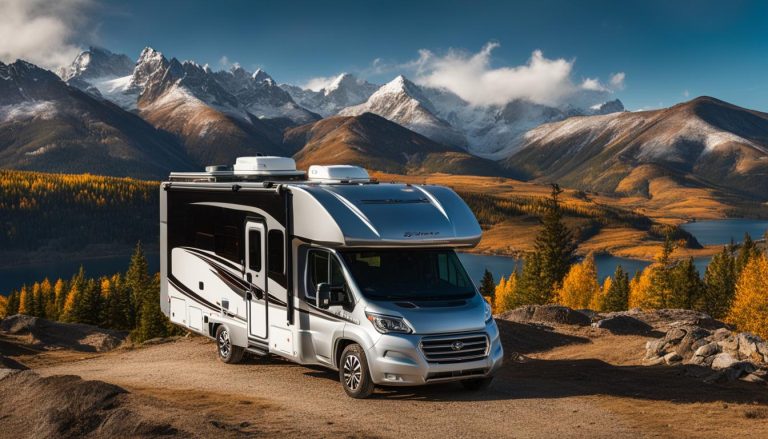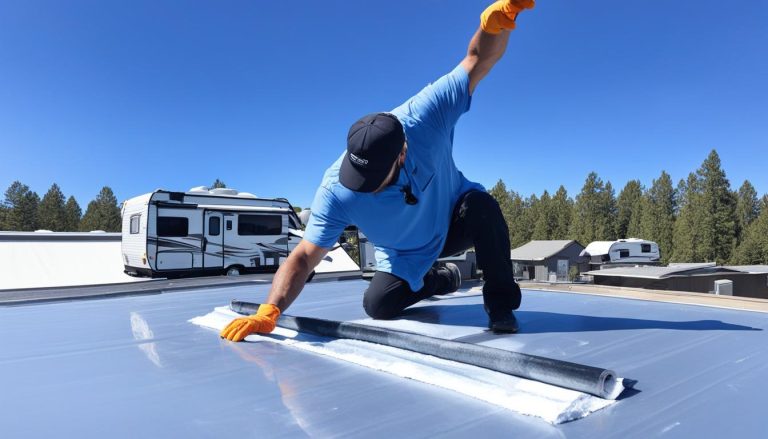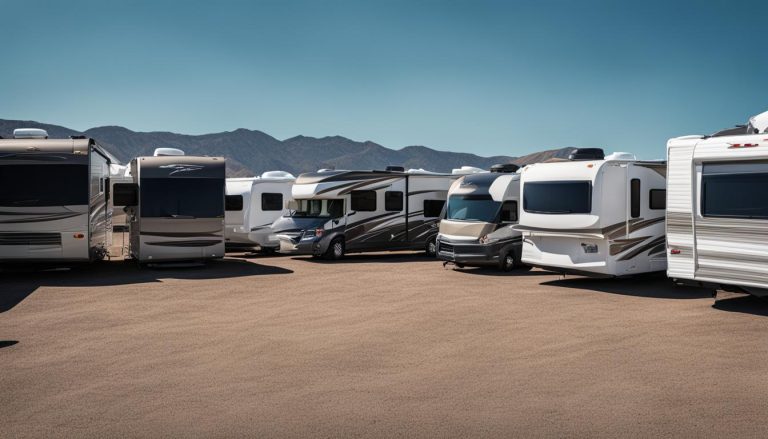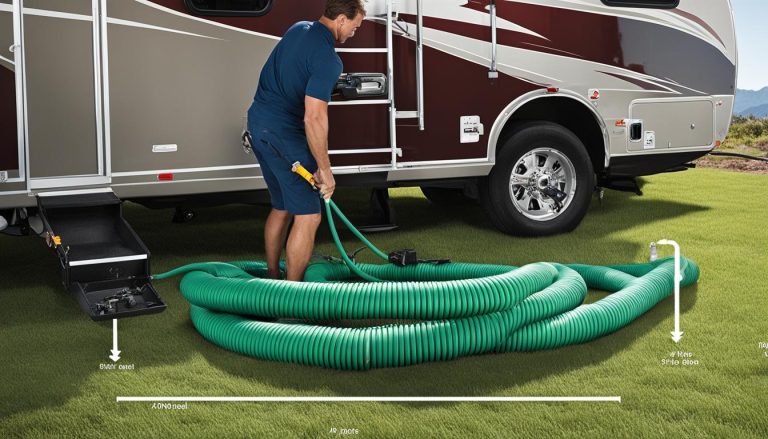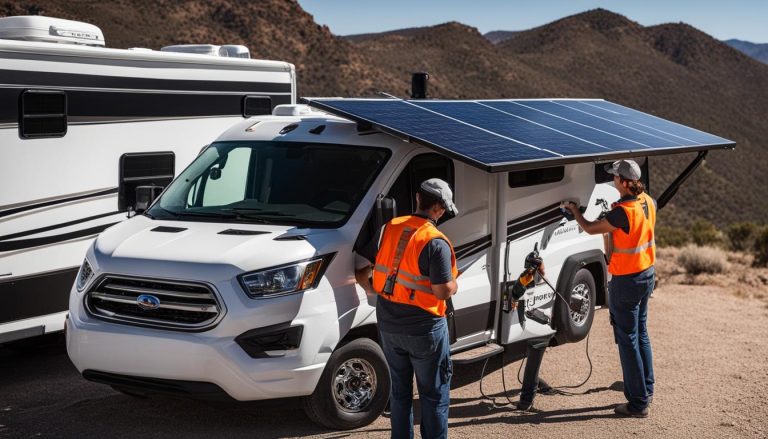Troubleshoot Your RV Refrigerator with Ease
gorvlifestyle.com and its partners may earn a commission if you purchase a product through one of our links
If you’re having issues with your RV refrigerator, don’t panic. Troubleshooting common problems and making simple repairs can often get your fridge back to optimal cooling without the need for a professional technician. It’s essential to understand how RV absorption refrigerators work and know where to look for potential issues.
RV absorption refrigerators function differently from residential fridges, as they rely on a combination of 12-volt direct current (DC) and either propane or 120-volt alternating current (AC) power. If your RV fridge is not cooling properly or not working at all, there are a few steps you can take to diagnose and resolve the problem.
Start by checking the control panel, cooling sources, and power sources. Ensure that the control panel is operational, the cooling sources (propane or AC power) are functioning correctly, and the power sources are connected and supplying power to the fridge. Sometimes, a simple fix like replacing a fuse or resetting the fridge can solve the issue.
Proper airflow is crucial for efficient cooling. Avoid overpacking the fridge, which can obstruct airflow. Check the door seals for any damage or leaks that might be compromising the cooling process. Additionally, inspect the exterior access panel and remove any obstructions that might impede the flow of air into and out of the fridge.
If you’ve gone through these troubleshooting steps and the fridge still isn’t cooling, there may be an issue with the cooling coils or other internal components. In such cases, it’s best to seek the assistance of a professional RV technician who can diagnose and repair the problem effectively.
Key Takeaways:
- Verify the control panel, cooling sources, and power sources to identify the root cause of the problem.
- Check the coach battery, 12-volt DC panel fuse, propane level, and AC power system to ensure they are all functioning correctly.
- Optimize airflow by avoiding overpacking the fridge, inspecting door seals, and removing obstructions from the exterior access panel.
- Allow the fridge sufficient time to cool after startup, and adjust the temperature using the thermistor or control panel.
- If DIY troubleshooting fails, consult an RV technician for further assistance.
How to Fix a Camper Refrigerator with Common Problems
If you’re experiencing issues with your RV refrigerator, you’re not alone. These appliances can encounter a range of problems that can be frustrating and disruptive to your camping experience. Fortunately, many of these issues can be resolved with some simple DIY repairs. In this section, we’ll explore some of the most common problems that can occur with RV refrigerators and provide you with practical tips on how to fix them.
“The most common problems with RV refrigerators are the pilot light not staying on, the cooling unit leaking, ammonia sediment buildup, frozen cooling unit, faulty burner, and insufficient cooling.”
1. Pilot Light Issues
If your RV refrigerator’s pilot light keeps going out, it’s likely due to a failing thermocouple or an air blockage in the gas line. To resolve this problem, you can try cleaning the thermocouple or removing any debris obstructing the gas line. If these steps don’t work, it may be necessary to replace the thermocouple altogether.
2. Leaking Cooling Unit
A leaking cooling unit can cause significant problems with your RV refrigerator. To fix this issue, you may need to replace the cooling unit or call a professional for repair. It’s important to address a leaking cooling unit promptly to prevent further damage to your refrigerator and ensure its continued functionality.
3. Ammonia Sediment Buildup
Ammonia sediment buildup can occur in RV refrigerators if they are left inactive for extended periods. To prevent this problem, it’s essential to regularly run your refrigerator and avoid long periods of inactivity. If ammonia sediment buildup does occur, you can try flushing the cooling system with a solution of water and vinegar to remove the deposits.
4. Frozen Cooling Unit
If your RV refrigerator’s cooling unit freezes, it can prevent the appliance from functioning correctly. To address this issue, you can use a lightbulb or space heater to gradually heat up the cooling unit and melt the blockage. However, it’s important to do this carefully and avoid using excessive heat, as it can damage the refrigerator.
5. Faulty Burner
A faulty burner can contribute to problems with your RV refrigerator’s performance. If you suspect a faulty burner, you can try replacing the thermocouple or cleaning the burner area to remove any debris or obstructions. Proper maintenance of the burner area can help ensure optimal performance from your RV refrigerator.
6. Insufficient Cooling
If your RV refrigerator is not keeping food cold enough, there are several factors you can troubleshoot. Check the airflow inside the refrigerator and ensure that it is unobstructed. Verify that the power sources, including the electrical and gas connections, are functioning correctly. Additionally, review the temperature controls and adjust them as needed.
If you’ve attempted these DIY repairs and are still experiencing issues with your RV refrigerator, it may be time to seek professional help. A trained RV technician can diagnose and resolve more complex problems, ensuring that your refrigerator operates at its best and keeps your food fresh during your camping adventures.
| Problem | Solution |
|---|---|
| Pilot light not staying on | Check thermocouple and gas line for issues, replace if necessary |
| Cooling unit leaking | Consider replacing the cooling unit or seek professional repair |
| Ammonia sediment buildup | Regularly run the refrigerator; flush with water and vinegar solution if necessary |
| Frozen cooling unit | Gradually heat up the unit with a lightbulb or space heater to melt the blockage |
| Faulty burner | Replace thermocouple or clean the burner area |
| Insufficient cooling | Check airflow, power sources, and temperature controls |
How to Troubleshoot RV Refrigerator Problems
To troubleshoot RV refrigerator problems, follow these steps:
- Verify if the refrigerator works in both electric and LP gas modes.
- Check the temperature using a thermometer or by feeling the cooling coils.
- If there is reduced airflow, inspect the evaporator fan in the freezer and the diffuser duct for clogs.
- If there is no cooling, check for an ammonia odor, which could indicate a leak in the cooling coils.
- If the refrigerator works on one power source but not the other, check for voltage and replace any faulty components like thermocouples or heating elements.
- If there is no power, check the circuit breakers, outlets, fuses, and ensure the batteries are charged.
- Clean the burner area and inspect the flame quality to troubleshoot gas-related problems.
- If all else fails, the cooling unit may need to be replaced or repaired by a professional.
Remember to follow proper safety precautions when handling electrical components and gas systems.
Common RV Refrigerator Problems
Here are some common issues you may encounter with your RV refrigerator:
- Insufficient cooling
- Faulty burner
- Freezing cooling unit
- Pilot light not staying on
- Leaking cooling unit
- Ammonia sediment buildup
If you experience any of these problems, refer to the troubleshooting steps above or consult a professional for assistance.
RV Refrigerator Troubleshooting Tips
“When troubleshooting your RV refrigerator, it’s important to be methodical and patient. Take the time to check each potential issue thoroughly before moving on to the next step.”
By following these troubleshooting tips, you can resolve many common RV refrigerator problems without the need for professional help. However, always prioritize your safety and seek professional assistance if needed.
How to Fix a Refrigerator with a Leaking Cooling Unit
A leaking cooling unit in an RV refrigerator can be a cause for concern. Not only can it result in unpleasant ammonia odors, but it can also leave behind yellow residue. If you have encountered this issue, it’s important to take action to prevent further damage and ensure the long-term functionality of your refrigerator. Here are some steps you can take to address a leaking cooling unit:
- Determine if the cooling unit needs to be replaced or repaired: Assess the severity of the leak and evaluate whether it is feasible to repair the cooling unit or if a replacement is necessary. In some cases, a simple repair may suffice, while in others, a replacement may be the most practical solution.
- Try the upside-down trick: If replacing the cooling unit is not an immediate option, you can try a technique that has been passed down through generations of RV enthusiasts. Turn your refrigerator upside down for a week to help dislodge any clogs in the unit. This method has been known to provide temporary relief and restore functionality to a leaking cooling unit.
- Consider long-term replacement: While the upside-down trick may offer a temporary solution, it is always recommended to eventually replace the cooling unit. By doing so, you can ensure that your refrigerator continues to operate efficiently and avoid any recurring issues in the future.
Remember, if you are unsure about how to fix a leaking cooling unit or if the problem persists after attempting these troubleshooting steps, it is best to consult a professional RV refrigerator technician. They have the expertise and experience to diagnose and resolve complex issues, ensuring the optimal performance of your RV refrigerator.
| Advantages | Disadvantages |
|---|---|
| Temporary relief of a leaking cooling unit | Replacement or repair may be necessary |
| Cost-effective solution | Upside-down trick may not be effective in all cases |
| No specialized tools required | Requires manual effort and time commitment |
By addressing a leaking cooling unit promptly and taking appropriate measures, you can ensure the optimal functioning of your RV refrigerator and enjoy worry-free travels.
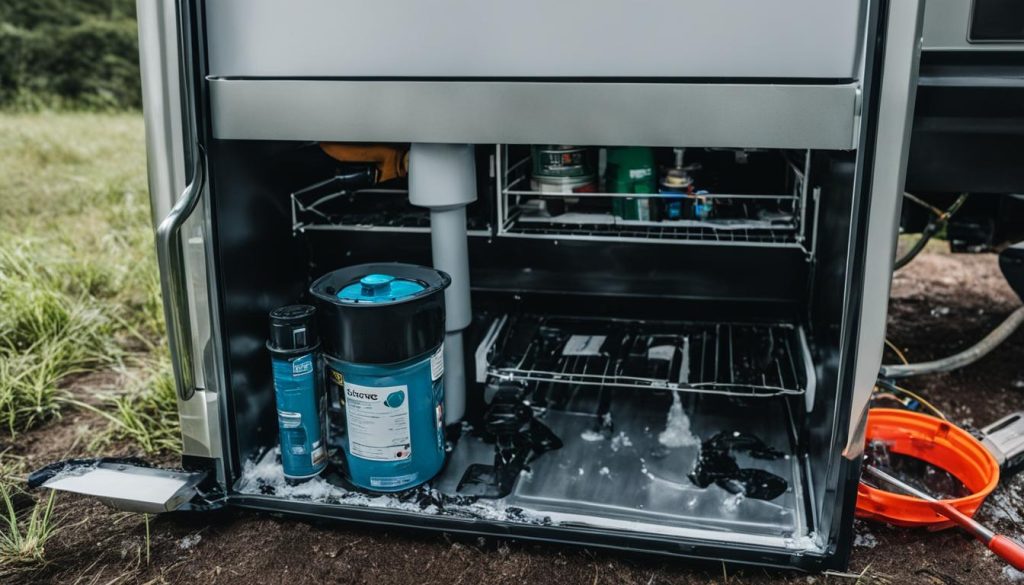
How to Troubleshoot RV Refrigerator Power Issues
Power issues are a common problem when it comes to RV refrigerators. If your refrigerator is not working on 120 Volts AC or LP gas, here are some troubleshooting steps to follow:
First, check the power sources and circuits. Ensure that the LP gas tank has sufficient gas and that the valve is open. If the LP gas flame doesn’t light or goes out quickly, it could be a sign of a faulty thermocouple. Clean the burner area to remove any debris that might be blocking the burner port.
If you’re experiencing power issues with the 120 Volts AC, check the circuit breakers, outlets, and heating element. Using a multimeter, you can test for voltage and replace any faulty components if necessary.
For power issues related to the 12 Volts DC, begin by checking the batteries, fuses, and switches. If you’re unsure about your electrical skills, it’s recommended to consult a professional for further assistance.
FAQ
How do I troubleshoot my RV refrigerator?
To troubleshoot your RV fridge, start by checking the control panel, cooling sources, and power sources. If the fridge is still not cooling, check the propane level and reset the fridge if it has gone into lockout. Ensure proper airflow inside and outside the fridge by not overpacking it, checking the door seals, and removing obstructions in the exterior access panel. If all else fails, there may be a problem with the cooling coils, and it’s best to contact an RV technician.
What are the most common problems with RV refrigerators?
The most common problems with RV refrigerators are the pilot light not staying on, the cooling unit leaking, ammonia sediment buildup, frozen cooling unit, faulty burner, and insufficient cooling. If these DIY repairs don’t work, it’s best to seek professional help.
How do I troubleshoot RV refrigerator problems?
To troubleshoot RV refrigerator problems, start by verifying if the refrigerator works in both electric and LP gas modes. Check the temperature using a thermometer or by feeling the cooling coils. If there is reduced airflow, check the evaporator fan in the freezer and the diffuser duct for clogs. If there is no cooling, check for an ammonia odor, which could indicate a leak in the cooling coils. If the refrigerator works on one power source but not the other, check for voltage and replace any faulty components like thermocouples or heating elements. If there is no power, check the circuit breakers, outlets, and fuses, and ensure the batteries are charged. Cleaning the burner area and checking the flame quality can troubleshoot gas-related problems. If all else fails, the cooling unit may need to be replaced or repaired by a professional.
How do I fix a refrigerator with a leaking cooling unit?
A leaking cooling unit in an RV refrigerator can cause ammonia odors and yellow residue. To fix this issue, first determine if the cooling unit needs to be replaced or repaired. If replacement is not an immediate option, try turning the refrigerator upside down for a week to unclog the unit. This may provide temporary relief and get the refrigerator working again. However, it is recommended to eventually replace the unit to ensure long-term functionality and avoid further issues.
How do I troubleshoot RV refrigerator power issues?
Power issues are common in RV refrigerators. If the refrigerator is not working on 120 Volts AC or LP gas, check the power sources and circuits. Verify that the LP gas tank has sufficient gas and that the valve is open. Clean the burner area to remove any debris that could be blocking the burner port. For power issues related to 120 Volts AC, check the circuit breakers, outlets, and heating element. Use a multimeter to test for voltage and replace any faulty components. If there is no 12 Volts DC power, check the batteries, fuses, and switches. It is recommended to consult a professional if electrical skills are limited.

